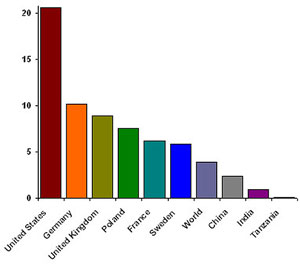|
|
 |
|
|
|
 |
| |
|
|
 |
How are
people changing
the climate?
Basics |
1. Man-made climate change?
Where do the emissions come from?
Of the greenhouse gases we emit, CO2 is the greatest contributor to the man-made increase in the greenhouse effect. Not only do we emit huge amounts of CO2, but it also takes a very long time to disappear from the atmosphere after it has been emitted. Since the Industrial Revolution, people have emitted large amounts of CO2 through the consumption of fossil fuels such as coal, oil, gasoline, and natural gas. |
|
|
|
|
 |
Fossil fuels are the most important
Almost all of the man-made CO2 emissions come from the consumption of fossil fuels – coal, oil, and natural gas. Fossil fuels are created from plants and animals that died millions of years ago, and lie far underground or under the ocean floor. When we burn these fuels, we release not only energy, but also CO2.
|
 |
 |
 |
|
1. SOURCES OF CO2 EMISSIONS FROM FOSSIL FUELS: Figures for all European countries, except states that belonged to the former Soviet Union, in 1995. Source: Edgar database (click to enlarge, 35 kB)
|
|
|
Although most emissions of CO2 come from natural sources, such as rotting vegetation, it is the emissions from human activity that tip the scales and create the imbalance that leads to global warming. This is because nature’s own emissions are part of a cycle whereby carbon rotates between the atmosphere, the oceans, and land-based vegetation. For example, both rotting trees and the respiration of animals and people emit CO2, while living plants and trees absorb equivalent amounts of CO2 through photosynthesis.
|
 |
 |
|
2. FOSSIL FUELS: A power plant that produces electricity from coal. Photo: Corel Gallery
|
|
 |
When we burn fossil fuels, we add carbon to the atmosphere that was not previously part of the cycle because carbon comes from deposits far underground or under the ocean floor that otherwise would have remained stored for the foreseeable future. Thus burning coal, oil, and gas adds more carbon to the cycle. This creates a surplus of CO2 that remains in the atmosphere for a long time. |
Deforestation also contributes
Burning wood or other types of biomass (dead organisms) also gives off considerable amounts of CO2. But if new trees or plants are allowed to grow in place of the forest or vegetation that was burned, then the new plants will absorb just as much CO2 as was released from the burning. Thus the cycle can come into balance again.
On the other hand, permanent deforestation creates imbalance and can increase the greenhouse effect in a number of ways. Deforestation means cutting down forests – by logging, using the wood for fuel, or converting the forested area to farmland or grazing areas – without replacing the lost trees with new ones. Regardless of whether the cut trees are burnt or allowed to decompose naturally, they will emit CO2. If new trees are not planted, then there is nothing to absorb the carbon released from the trees that were cut down, and this will increase the amount of the CO2 in the atmosphere.
|
 |
 |
 |
|
3. FORESTS: Living trees trap CO2 from the atmosphere, while wood burning or rotting releases the CO2 again. So cutting down trees without planting new ones will increase the CO2 concentration in the atmosphere. If wood is used as a building material, the release of CO2 may be delayed for as long as the house stands. Photo: The NOAA Photo Library
|
|
Methane is also a culprit
While CO2 is the most important greenhouse gas – mainly because there is so much of it – it is not the only greenhouse gas we need to worry about. Methane (CH4) is also a very powerful greenhouse gas, although it has a much shorter lifetime than CO2. Like CO2, methane comes from both natural and man-made sources. Natural sources include rotting wood and wetlands, while human activities that emit methane include agriculture, ranching, and waste deposits. Other greenhouse gases also contribute to manmade climate change. They include nitrous oxide (N2O) and several synthetic compounds from industry containing fluorine (these are known as HFCs, PFCs and SF6).
|
Rich countries emit the most
The biggest emitters of greenhouse gases are rich, industrialized countries like the EU countries and the United States. The per capita emissions in a rich country are several times greater than the per capita emissions in a poor country (see figure 4). However, as the poorest countries develop and increase their standards of living, they are likely to experience a tremendous growth in emissions. Today, China is the country with the second highest total emissions (after the United States). India has increased emissions by over 50% since 1990, and is now ranked number six. There is nevertheless far to go before the developing countries catch up with the rich countries when it comes to per capita emissions.
|
 |
 |
 |
|
4. EMISSIONS: The bars show how many tons of CO2 that are emitted per person (per capita) in some countries. Source: IEA (click to enlarge, 29 kB)
|
|
|
This was the last page in this unit. Go to worksheets. |
|
Author: Camilla Schreiner - CICERO (Center for International Climate and Environmental Research - Oslo) - Norway. Scientific reviewers: Andreas Tjernshaugen - CICERO (Center for International Climate and Environmental Research - Oslo) - Norway - 2004-01-20 and Knut Alfsen - Statistics Norway - Norway - 2003-09-12. Educational reviewer: Nina Arnesen - Marienlyst school in Oslo - Norway - 2004-03-10. Last update: 2004-03-27. |
|
 |
|









